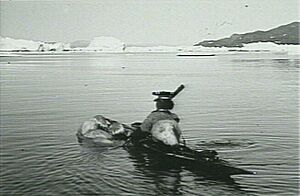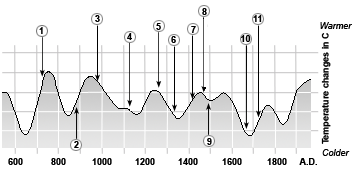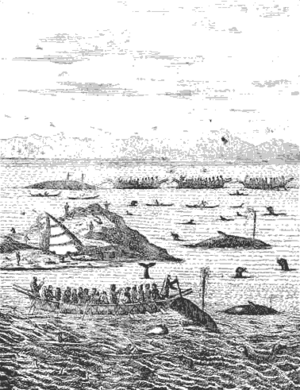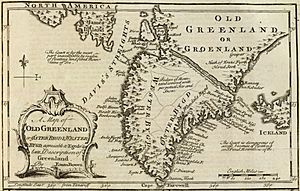History of Greenland facts for kids

The history of Greenland is about life in a very cold place. Most of the island is covered by a huge ice sheet. This means people mostly live along the coasts. The first people arrived in Greenland around 2500 BCE. These early groups disappeared, and new groups came from North America.
Europeans, like the Norsemen from Iceland, didn't know about Greenland until the 800s CE. They settled on the southwest coast. The ancestors of today's Greenlandic Inuit people arrived later, around 1200 CE, from northwestern Greenland.
During a very cold period called the Little Ice Age, the Norse settlements disappeared. The Inuit were the only people left on the island for hundreds of years. Even without contact, Denmark-Norway still claimed Greenland. In 1721, Denmark-Norway sent missionaries to Greenland. They wanted to bring Christianity back to the Norse people they thought were still there. When they found no Norse descendants, they taught the Inuit about Christianity instead. Denmark-Norway then set up trading posts and controlled all trade.
During World War II, Nazi Germany invaded Denmark. This made Greenlanders less connected to Denmark and more connected to the United States. After the war, Denmark took control again. In 1953, Greenland changed from a colony to a county. Greenland is still part of the Kingdom of Denmark, but it has had its own home rule government since 1979. In 1985, Greenland decided to leave the European Economic Community (EEC), which it had joined with Denmark in 1973.
Contents
Early People of Greenland
Greenland's early history is about different groups of people, called Paleo-Inuit, moving there many times. These groups came from islands north of North America. They were likely descendants of people from Siberia who crossed into North America long ago. Living in Greenland was very hard because of its cold climate. Over time, one group would die out, and new people would arrive.
The first known groups were the Saqqaq culture (2500–800 BCE) and the Independence I culture (2400–1300 BCE) in northern Greenland. They came from different parts of North America. Around 800 BCE, the Independence II culture appeared in the same area. Later, the early Dorset culture (700 BCE–1 CE) arrived. Some experts now think the Dorset culture in Greenland was a continuation of the Independence II culture.
After the Early Dorset culture disappeared around 1 CE, Greenland was empty for a while. Then, around 700 CE, Late Dorset people settled in northern Greenland. This culture lasted until about 1300 CE. Meanwhile, the Norsemen arrived in the southern part of the island in 980 CE.
Norse People Arrive
Europeans probably first learned about Greenland in the late 800s. A Norse sailor named Gunnbjörn Ulfsson was blown off course and saw some islands near Greenland. In the 980s, explorers led by Erik the Red sailed from Iceland and reached Greenland's southwest coast. Erik called the island "Greenland" because he thought a good name would make people want to move there.
Stories say Erik the Red was exiled from Iceland for three years around 982. He sailed to Greenland, explored the coast, and claimed land. He then went back to Iceland to convince people to join him. About 25 ships left Iceland with Erik in 985, but only 14 made it safely to Greenland. Scientists have found evidence that supports this timeline. Around the year 1000, Erik's son, Leif Erikson, explored areas around Vinland, which is thought to be in present-day Newfoundland.
The Norse people built settlements along the fjords in southwestern Greenland. They might have cleared trees for building and fuel. Their sheep and goats grazed the land. This clearing and grazing could have caused soil to wash away, which might have hurt their settlements later.
The Norse had three main settlements: the larger Eastern Settlement, the smaller Western Settlement, and the tiny Middle Settlement. At their peak, between 2,000 and 10,000 people lived there. Archaeologists have found the remains of about 620 farms.
The Norse Greenlanders made a living by farming, hunting, and some fishing. They raised cattle, sheep, and goats for milk, cheese, and butter. Most of their meat came from hunting caribou and seals. They also went on summer trips to hunt walruses, narwhals, and polar bears. They used the skins, hides, and ivory from these animals. These items were also important for trading with Europe.
Greenland's Norse people traded walrus tusks (ivory), rope, sheep, seals, wool, and cattle hides with Europe. They needed iron tools, wood (especially for boats), and extra food from Iceland and Norway. For a while, trade ships came to Greenland every year. But starting in the late 1200s, all ships from Greenland had to sail directly to Norway. The climate also started getting colder in the 1300s and 1400s, during the Little Ice Age.
In 1126, the Roman Catholic Church set up a church area in Garðar. It was part of the Norwegian church system. We know of at least five churches in Norse Greenland from old ruins. In 1261, the people accepted the King of Norway as their ruler, but they still had their own laws.
Norway and Sweden were united for a time, and Greenland was part of this union. Ships continued to visit Greenland.
Why the Norse Settlements Disappeared

1. Late Dorset Culture people move into northern Greenland (700-750).
2. Norse settlement of Iceland begins (late 800s).
3. Norse settlement of Greenland begins (just before 1000).
4. Thule Inuit move into northern Greenland (1100s).
5. Late Dorset culture disappears from Greenland (late 1200s).
6. The Western Settlement disappears (mid-1300s).
7. The last known written record about the Norse in Greenland (1408).
8. The Eastern Settlement disappears (mid-1400s).
9. John Cabot visits Labrador - Newfoundland (1497).
10. "Little Ice Age" (around 1600 to mid-1700s).
11. Norwegian missionary Hans Egede arrives in Greenland (1721).
The Norse settlements in Greenland lasted for about 450 to 500 years (from 985 to 1450–1500). Many ideas explain why they disappeared. Some possible reasons include:
- Damage to the environment over time.
- Changes in the climate, making it colder.
- Less contact and support from Europe.
- Not adapting well to the harsh environment.
- New opportunities in Iceland and Norway after the Black Death.
- The value of walrus ivory going down in Europe.
Many studies have looked into these ideas. Some experts believe the Norse people didn't starve but might have left for Iceland or another place. However, archaeological findings at their old farms don't show signs of attacks. The lack of personal items suggests they left in an orderly way, taking useful things with them. But it could also mean they slowly became very poor. Old trash piles show that their diet became less varied over time.
Some historians think that the Norse people were not attacked by the Inuit. Instead, their society slowly declined as the climate got worse. Also, the value of walrus ivory dropped because elephant ivory from Africa became available.
Greenland was always colder than Iceland and Norway, and farming was harder there. Soil erosion was a problem from the start. For a long time, a warm ocean current helped the Norse farm. But studies of old plant remains show that the Greenlanders struggled with soil erosion and cutting down too many trees. One Norse farm was buried under 10 feet of sand. As farming became harder, they turned more to hunting. But they never learned the hunting skills of the Inuit, who were experts at hunting in icy areas.
Scientists have studied ice from Greenland's ice cap. These ice samples show that the Medieval Warm Period made Greenland's climate milder from about 800 to 1200. But from around 1300, the climate started to cool. By 1420, the "Little Ice Age" was very strong in Greenland. Digs at Norse farms show that they ate fewer cows and pigs and more sheep and goats. As winters got longer, there was less time to grow hay for animals. Studies show summer temperatures dropped a lot in the late 1200s and early 1300s. The coldest winters in 2,000 years happened in the late 1300s and early 1400s. By the mid-1300s, bones from a rich farm showed many cattle and caribou. But a poorer farm nearby had only seal bones. This shows that the Norse diet changed from 20% sea animals to 80% by the 1300s.
The Thule people (ancestors of today's Inuit) moved south and met the Norse in the 1100s. The Norse called the Inuit "skraelings." There is some evidence that the two groups traded. Inuit items have been found at Norse sites, and Norse items at Inuit sites. Some historians believe relations between the Inuit and Norse were mostly friendly.
The Norse never learned how to use kayaks or hunt seals like the Inuit. By 1300, the Inuit had settled close to the Norse Western Settlement. By 1350, the Norse had completely left their Western Settlement. A ship sent by the king in 1355 found the settlements still Norse and Christian. The last known ship to Greenland sank in 1369 and was not replaced. Some believe the Norse left for Iceland or Scandinavia because of the worsening climate and economy.
Greenlanders needed to stay in touch with Iceland and Norway for trade. Greenland did not have much wood, so they depended on ships from Iceland or possibly trips to the Canadian coast for lumber.
The main thing Greenlanders traded was walrus tusks. These were used in Europe as a substitute for elephant ivory in art. Some think there was also a valuable trade in narwhal tusks.
Some believe that the Norwegian king's control over shipping contributed to the end of trade. However, Christianity and European customs continued among the Greenlanders for most of the 1300s and 1400s. In 1921, a historian found human remains from the Eastern Settlement. The bodies wore 15th-century clothes and showed no signs of starvation. Most had crosses around their necks. Church records from 1345 say Greenlanders were excused from paying taxes because they were poor. The last known ship to reach Greenland was in 1406. It left in 1410.
After 1408, there are few written records about the Norse settlers. A letter from the Pope in 1448 asked for priests and a bishop for Greenland. It said they hadn't had one for 30 years after an attack by "heathens." It's likely the Eastern Settlement was gone by the mid-1400s. In the 1540s, a European ship found the body of a Norse man there. This might be the last mention of a Norse person from the settlement.
Genetic Information
Studies of DNA show that Inuit men in Western Greenland have some European genes. This could be from the early Norse settlers (1000-1200 AD) or from later Danish settlers in the 1700s. However, the DNA from women shows that Inuit women's family lines are almost completely shared with other Inuit groups. This means that European genes in Greenlandic people mostly came from European men.
Late Dorset and Thule Cultures
The Late Dorset culture lived in Greenland until the early 1300s. They were mostly in the northwest, far from the Norse in the south. This culture existed before the Norse or Thule people settled there. Archaeologists have found evidence of gathering places for four to thirty families.
Around 1300–1400 CE, the Thule people arrived from the west. They settled in the northeast of Greenland. These people are the ancestors of the modern Greenland Inuit. They were very good at hunting almost all animals on land and in the ocean, including walrus, narwhal, and seals. The Thule adapted well to Greenland's environment.
It's not clear how much the Dorset and Norse cultures interacted. There might have been some trading. The level of contact is still being studied.
Danish Return to Greenland
Many old Norse records about Greenland were lost in a fire in Copenhagen in 1728. It was hard to reach Greenland's east coast for a long time because of ice. This led to confusion about maps. But explorers kept trying to find a Northwest Passage to Asia. Many expeditions visited Greenland's coast in the 1400s, 1500s, and 1600s.
After Sweden left the Kalmar Union, Denmark and Norway became one country in 1536. To show their claim to Greenland, the Greenlandic polar bear was added to the Danish coat of arms in the 1660s. In the late 1600s, ships from many European countries hunted whales off Greenland's east coast. They often came ashore to trade and get fresh water. Later, Danish traders made it illegal for foreign ships to trade.
From 1711 to 1721, a Norwegian church leader named Hans Egede asked the King of Denmark for money to go to Greenland. He wanted to find the Norse settlers and teach them about the Protestant faith. The king allowed Egede and some merchants to start a company to trade with Greenland. Egede found the ruins of the Norse colony but didn't realize what they were. He struggled with attacks from Dutch traders. An attempt to start a royal colony in 1728 failed, and many settlers died.
In 1733, two Inuit children who had gone to Copenhagen returned to Greenland with smallpox, which caused a terrible sickness on the island. The same ship brought the first Moravian missionaries. They had more success teaching the Inuit about Christianity. Around the same time, a merchant named Jacob Severin took over the colony's trade. He got a royal monopoly and successfully fought off the Dutch traders. Egede left Greenland after his wife died, and his son, Paul Egede, continued the mission. Both Hans and Paul Egede studied the Kalaallisut language and wrote books about it. They also studied Greenland's plants, animals, and weather.
During the Napoleonic Wars, Norway was given to Sweden in 1814. But Greenland and other colonies stayed with Denmark. The 1800s saw more interest in Greenland from explorers and scientists. The first Greenlandic-language newspaper was started in 1861. Danish law only applied to Danish settlers. In the late 1800s, Inuit families from North America moved to northern Greenland.
Greenland held its first democratic elections for local assemblies in 1862–1863. But there was no assembly for the whole island. In 1888, a group led by Fridtjof Nansen made the first land crossing of Greenland on skis. In 1911, two regional assemblies were created, one for northern and one for southern Greenland. Most decisions were still made in Copenhagen, where Greenlanders had no say. Traders criticized Denmark's trade monopoly, saying it stopped Greenlanders from developing a fishing industry. However, many Greenlanders liked the monopoly because they felt it protected whaling.
By 1911, Greenland's population was about 14,000, mostly along the southern coasts. Almost all were Christian because of the missionaries.
Important Location
Greenland became very important for its location.
World War II
During World War II, Nazi Germany started military actions in Greenland. Henrik Kauffmann, the Danish Ambassador to the United States, signed a treaty with the US on April 9, 1941. This allowed the US to set up stations in Greenland. Kauffmann did this without the Danish government's permission. Because it was hard for Denmark to control the island during the war, Greenland became quite independent. The United States provided supplies.
Cold War
During the Cold War, Greenland was very important. It controlled parts of the sea route between the Soviet Union's Arctic ports and the Atlantic Ocean. It was also a good place to watch for intercontinental ballistic missiles. The US offered to buy Greenland for $100 million, but Denmark said no. In 1951, a new treaty was signed, and the Thule Air Base in the northwest became a permanent US base. In 1953, some Inuit families were forced to move from their homes to make space for the base. This has caused problems between the Danish government and the Greenlandic people. In 1968, a US B-52 plane crashed near Thule Air Base, spreading radioactive material. One of the bombs was never found.
Home Rule for Greenland
The American presence in Greenland brought new goods and ideas. From 1948 to 1950, a commission studied Greenland to improve its economy and reduce its isolation. The old trade monopolies were finally removed. In 1953, Greenland changed from a colony to an autonomous province of Denmark. Greenland also got its own Danish county and some representation in the Danish Parliament.
Denmark started reforms to make Greenlanders live more in towns. This was to help them find new jobs as seal populations decreased and cod fishing grew. These changes led to some problems, like unemployment and poor housing projects. For example, the Blok P housing project was built without thinking about local needs. Inuit people couldn't fit through the doors in their winter clothes, and fire escapes were blocked by fishing gear. Television broadcasts started in 1982. When cod fishing and mines declined in the late 1980s and early 1990s, Greenland's economy was hurt. Now, it mainly relies on Danish aid and shrimp exports.
Greenland had little say in the Danish Parliament. So, even though 70.3% of Greenlanders voted against joining the European Common Market (EEC), they joined with Denmark in 1973. People worried that foreign companies would overfish their waters, and these fears came true. Local parties began to push for more self-rule. The Danish Parliament approved this in 1978. The next year, Greenland got home rule with its own local Parliament. On February 23, 1982, a small majority (53%) of Greenlanders voted to leave the EEC. They officially left in 1985.
Greenland's home rule has focused on promoting Greenlandic culture and language. The capital Godthåb was renamed Nuuk in 1979. A local flag was adopted in 1985. Following a successful vote for self-government in 2008, the local parliament's powers grew, and Danish was removed as an official language in 2009.
Greenland now handles most of its own international relations. As part of leaving the EEC, Greenland was given special access to the EEC market as part of Denmark. Greenland is also part of several organizations with Iceland, the Faroes, and Inuit groups in Canada and Russia. It helped create the Arctic Council in 1996. The US military bases on the island are still a big topic. Some politicians want the home rule government to renegotiate the 1951 US–Denmark treaty.
Images for kids
See also
 In Spanish: Historia de Groenlandia para niños
In Spanish: Historia de Groenlandia para niños
- Danish colonization of the Americas
- History of America
- History of Denmark
- History of Iceland
- History of Norway
- Indigenous Amerindian genetics
- Inuit
- Inuit mythology
- Norse colonization of the Americas
- Christian IV's expeditions to Greenland









